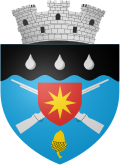Darabani
| Darabani | ||||
|
||||
| Basic data | ||||
|---|---|---|---|---|
| State : |
|
|||
| Historical region : | West Moldova | |||
| Circle : | Botoșani | |||
| Coordinates : | 48 ° 11 ' N , 26 ° 26' E | |||
| Time zone : | EET ( UTC +2) | |||
| Height : | 260 m | |||
| Area : | 99.85 km² | |||
| Residents : | 9,893 (October 20, 2011) | |||
| Population density : | 99 inhabitants per km² | |||
| Postal code : | 715100 | |||
| Telephone code : | (+40) 02 31 | |||
| License plate : | BT | |||
| Structure and administration (as of 2016) | ||||
| Community type : | city | |||
| Structure : | 3 districts / cadastral communities: Bajura , Eșanca , Lișmănița | |||
| Mayor : | Liviu Țîmpau ( PNL ) | |||
| Postal address : | Str. 1 Decembrie, no. 100 loc. Darabani, jud. Botosani, RO-715100 |
|||
| Website : | ||||
| Others | ||||
| City Festival : | September | |||
Darabani ( ) is a town in Botoșani County in Romania .
location
Darabani is located in the Moldau Plain ( Câmpia Moldovei ), on a plateau south of the Prut River . The district capital Botoșani is about 50 km south. Darabani is the northernmost city of Romania and borders on the border triangle with Ukraine and the Republic of Moldova .
Surname
The name Darabani is of Hungarian origin and derived from "soldier". In Romania the name Dărăbani is often used, which corresponds to the "Wallachian" understanding of the Romanian language. The official city name, however, is the "Moldovan" form Darabani .
history
The region of the present city has been around since 3000–4000 BC. Settled. Darabani was first mentioned in 1546 under the name Căbiceni . The name Darabani has been documented since 1725. In 1841 the first village school in what was then the Principality of Moldova was built in the village . In the 19th century in particular, Darabani was characterized by a strong Jewish population. In the years 1877 and 1878, there were isolated violent disputes between Jews and Romanians, as well as court proceedings relating to land ownership issues. In 1968 Darabani was declared a town. However, this is still predominantly rural; the soils around Darabani are very fertile and favor agriculture and livestock farming.
population
In 1930 10,748 people lived in the city, of whom in 1917 they described themselves as Jews and almost all of the rest as Romanians . In the 2002 census, the city had 11,820 residents, including 11,812 Romanians; In 2011, 9893 inhabitants were registered, including 9433 Romanians.
traffic
Darabani has no rail connection. There are bus connections to Botoșani several times a day. The National Road Drum național 29A runs through the city .
Attractions
- Sfântu Nicolae Church (1837)

